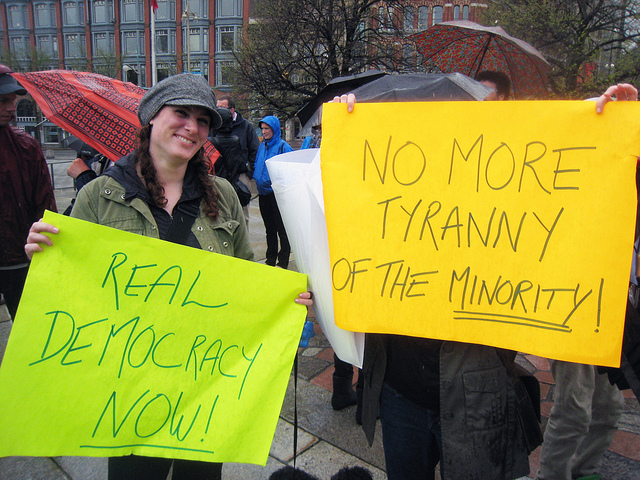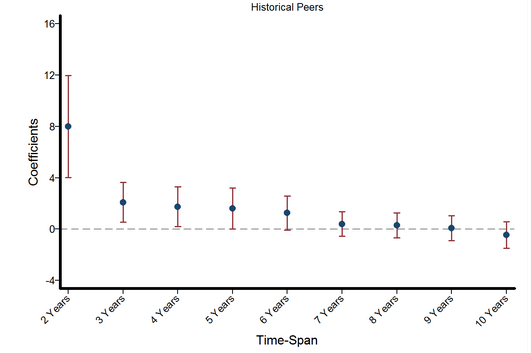The take-up of mechanisms designed to temper proportional representation shows that countries don’t choose their electoral systems and rules in a vacuum
Some countries attempt to ‘temper’ the political party system unpredictability by introducing measures to halt fragmentation, such as representation thresholds. Here, Damien Bol, Jean-Benoit Pilet, and Pedro Riera argue that national legislators are more likely to adopt one of these electoral mechanisms when a large number of other countries have made similar choices in recent years.

Credit: ahblair, CC BY SA 2.0
These last decades, the possibility of changing the electoral system has been brought at the political agenda of many democracies. In 2011, the Tory-LibDem government organised a referendum on the convenience of replacing the first past the post system used to elect the House of Commons by an Australian-like alternative voting system. In the 1990s, the Italian government implemented a variant of the German mixed-member system for the election of the lower house of the national parliament. About 10 years later, the decision was made to turn back to a proportional representation system with a seat bonus for the largest coalition. During the 2012 presidential election campaign in France, several candidates (including the current President Hollande) advocated the introduction of some dose of proportionality in the two-round system used for legislative elections.
Following these events, a broad community of researchers has been studying the reasons why governments and legislators choose an electoral system over others. According to many, the ruling elite seeks to secure its positions by anticipating the effect of various possible electoral systems on the allocation of seats. Despite their international and comparative focus, the assumption is often made, usually implicitly, that episodes of electoral system choice are independent from each other. Actors involved in these processes are often presented as being completely unaware of, or at least not affected by, what is happening abroad. Yet there is no reason to discard the possibility of international diffusion of electoral systems. In a recent article, we use data from European countries between 1945 and 2011 to test the hypothesis according to which the adoption of electoral systems that are superior in terms of electoral outcomes tends to spread among peer countries.
The case for limited proportional representation
Every electoral system has pros and cons. One of the fundamental issues for electoral engineering is the trade-off between fair representation and accountability. Proportional representation tends to produce more inclusive parliaments than first past the post. However, the system’s rules also result in a greater number of parties in parliament, and therefore a decrease in the chances that a single party will win an absolute majority of seats. Under such circumstances, governments are usually composed of coalitions of more than one party, which tend to undermine the identification of which parties are to blame (or to be rewarded) for good and bad policy outcomes.
In 2011’s article, Carey and Hix have changed our perceptions of this trade-off by arguing that an electoral ‘sweet spot’ exists. This sweet spot emerges when a system tempers pure proportional representation to produce an arrangement wherein excessive party fragmentation and the unfair exclusion of small parties are balanced, thereby achieving the most efficient representation. According to them, a proportional representation system that is combined with either low-magnitude multimember districts or high electoral thresholds can hit the electoral sweet spot. Our article builds on this by arguing for the diffusion of low district magnitudes and high electoral thresholds in the after World War II period in Europe.
Analyses
In our article, we analyse spatial-temporal trends in the use of low district magnitudes and high electoral thresholds in proportional representation systems of European countries between 1945 (or the first democratic election) and 2011. To do so, we rely on data collected within the Electoral System Change in Europe since 1945 project, for which national experts have been invited to translate the electoral rules of all European democracies.
Our sample shows quite a large variation in the usage of low district magnitudes and high electoral thresholds. While some countries have continuously used at least one of these mechanisms and often both (especially recent democracies such as Estonia, Hungary or Lithuania), other countries, such as Finland, Luxembourg and the Netherlands, have never implemented any of them. On average, 75% of European countries have used at least one of the mechanisms at one point in time.
We also observe an overall increase in the use of at least one of the two electoral mechanisms. This increase is particularly striking in the 1990s following the democratisation of Central and Eastern European countries. These countries massively adopted high electoral thresholds, which are nowadays used to elect national legislatures in more than 50% of European democracies employing proportional representation (although they were almost never used at the beginning of the covered period). By contrast, the overall use of low district magnitudes remains relatively constant over the sampled period (at around 30%-40%). The following table describes the countries included in our analysis, and the first election and last election for which low district magnitudes and high electoral thresholds have been used.
| Country | First democratic election | Low magnitudes | High thresholds |
| Austria | 1949 | [1949-1969][1994-…] | |
| Belgium | 1946 | [1946-1984] | [2003-…] |
| Bulgaria | 1990 | [1990] | |
| Croatia | 1992 | [1995-…] | |
| Cyprus | 1981 | [1981-1984] | [1981-1995] |
| Czech Republic | 1996 | [1996-…] | |
| Denmark | 1947 | [1947-1970][1997-…] | |
| Estonia | 1992 | [1992-…] | |
| Finland | 1948 | ||
| Germany | 1949 | [1949-…] | |
| Greece | 1977 | [1977-…] | [1977-1985] |
| Hungary | 1990 | [1990-…] | [1994-…] |
| Iceland | 1946 | [1946-…] | [2003-…] |
| Italy | 1948 | [1994-2005] | |
| Latvia | 1993 | [1995-…] | |
| Lithuania | 1992 | [1992-…] | [1996-…] |
| Luxembourg | 1945 | ||
| Netherlands | 1946 | ||
| Norway | 1949 | [1949-1972] | |
| Poland | 1991 | [1993-2000] | [1993-…] |
| Portugal | 1976 | ||
| Romania | 1990 | [2000-…] | |
| Slovakia | 1994 | [1994-…] | |
| Slovenia | 1990 | ||
| Spain | 1979 | [1979-…] | |
| Sweden | 1948 | ||
| Switzerland | 1947 |
To test our hypothesis, we estimate logistic models predicting the adoption of either low district magnitudes or high electoral thresholds according to the proportion of peer countries having adopted them within a given time-span. We use several definitions of peer countries, namely historical (same democratisation period), linguistic (same linguistic group), and geographical (common boundaries). The figure below reports the coefficient estimates (and the 95% confidence intervals) associated with the diffusion variable for low district magnitudes, for historical peer countries, and for all time-spans between two (i.e., the current and the immediately preceding years) and ten years.
We see that the effect of diffusion diminishes as the time-span increases. The diffusion effect is strong and statistically significant when diffusion is defined as the proportion of adoptions among peer countries within the last two, three or four years. This effect is much smaller when the diffusion time-span is set at five years (and more). These results suggest that the diffusion trends among peer countries are rather short-lived and that the adoptions abroad stop having an influence on domestic decisions after a couple of years. The results are similar for adoption of high electoral thresholds.
These effects are robust to various statistical specifications, to our three definitions of peer countries, and to the inclusion of various controls including those capturing the classical explanation of electoral system choice (i.e., seat-maximisation and party system fragmentation). As further evidence supporting this argument, we also find elements of diffusion in parliamentary debates surrounding episodes of electoral system change in several countries.
Conclusion
Despite the international and comparative focus of much of the scientific work on electoral system choice, the literature still often fails to take into consideration that electoral engineering processes at the national level do not occur in a vacuum. Our empirical analysis supports the existence of short-lived international trends in the adoption of low district magnitudes and high electoral thresholds. The likelihood that a country adopts one of these arrangements increases with the number of peer countries that have recently adopted a similar system.
The main contribution of this article is to highlight the need of taking into account the diffusion of innovation across countries in works on electoral adoption and reform, as well as more broadly in research on institutional choice.
—
To see the article on which this post is based, click here. It represents the views of the author and not those of Democratic Audit UK or the LSE. Please read our comments policy before posting. ![]()
—
 Damien Bol is a political science postdoctoral fellow at the Canadian Research Chair in Electoral Studies of the University of Montreal.
Damien Bol is a political science postdoctoral fellow at the Canadian Research Chair in Electoral Studies of the University of Montreal.
 Jean-Benoit Pilet is professor of political science at Universite libre de Bruxelles (
Jean-Benoit Pilet is professor of political science at Universite libre de Bruxelles (
 Pedro Riera is a social sciences faculty member at the University of Carlos III Madrid
Pedro Riera is a social sciences faculty member at the University of Carlos III Madrid






 Democratic Audit's core funding is provided by the Joseph Rowntree Charitable Trust. Additional funding is provided by the London School of Economics.
Democratic Audit's core funding is provided by the Joseph Rowntree Charitable Trust. Additional funding is provided by the London School of Economics.
Adoption of new electoral systems is bound to be a slow process not least because for there are various tradeoffs within the various systems to be considered.
A radical system based on pure party PR and single member constituency representatives but with underlying logic at least comparable, if not superior, to mixed member systems challenges this orthodoxy.
Ref. https://www.dprvoting.org
and a two page short description
https://www.dprvoting.org/PDFs/Short_description.pdf
Take-up of mechanisms to temper proportional representation shows countries don’t pick electoral systems in a vacuum https://t.co/ncTVG6Nw5w
@democraticaudit: Countries don’t choose their electoral systems in a vacuum https://t.co/veEyLsdK8m analysis of influence of other countries
@democraticaudit: Countries don’t choose their electoral systems and rules in a vacuum https://t.co/veEyLsdK8m analysis of peer influence
Countries don’t choose their electoral systems and rules in a vacuum https://t.co/N8nXQGlHR4
The take-up of mechanisms designed to temper proportional representation shows that countries don’t choose their e… https://t.co/3EVqC1CmFi
On the @democraticaudit blog, countries are more likely to adopt electoral system if other countries have done so: https://t.co/OAop3hzDNY